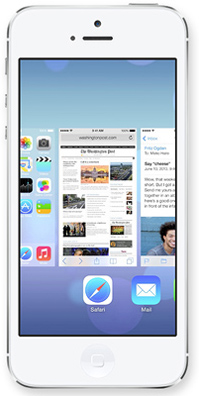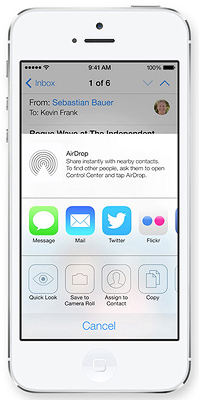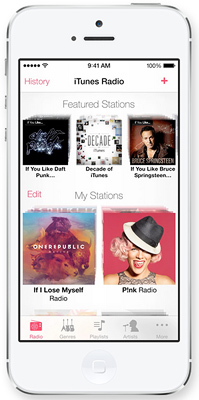Apple’s New Mobile OS Is All about Ive
For Apple, there’s a lot riding on iOS 7, the newest version of its mobile software and the first refresh overseen by veteran industrial design head Jonathan Ive. To satisfy as many people as possible, it seems, Apple took inspiration from several different sources—including competitors.

The iPhone and iPad maker unveiled the new software, which it is offering to developers and will be available to consumers in the fall, along with a flurry of other updates, Monday at its 24th annual developer conference in San Francisco. Other announcements included Mavericks, the latest version of its OS X desktop software, a Pandora competitor dubbed iTunes Radio, and a sneak peek of its forthcoming Mac Pro, a sleek-but-sinister-looking tube-shaped black device.
iOS 7 was the center of attention, though, since its success will help define Apple’s future in a world increasingly focused on smartphones and tablets—a world Apple did much to build. A refresh is needed, however, since it’s harder to keep the interest of consumers, many of whom are gravitating to competing mobile operating systems, like Google’s Android and Microsoft’s Windows Phone. The mobile computing market has gotten a hell of a lot more competitive since the company trotted out the first iPhone in 2007, but while Apple has added plenty of features to the software, changed the design of the handset, and introduced the iPad, it has never truly overhauled the look of iOS.

And for Ive, it’s a chance to infuse Apple’s software with the minimal, modern design sense he’s instilled into Apple’s hardware for more than a decade. He took the reins as Apple’s “human interface” director in October when Scott Forstall (who had led iOS development from the beginning) departed after the widely criticized launch of Apple Maps.
The “skeuomorphic” design ethos—with virtual buttons that appear as though they could be physically pushed and a notepad app that looks like a legal pad—that defined Forstall’s tenure isn’t gone in iOS 7. But it has definitely been toned down. The new look is flatter, cleaner, more futuristic (see “Why Jony Ive Shouldn’t Kill Off Skeuomorphic Interfaces”). In some ways, the brighter colors and slimmer-looking typography evoke design tropes that Microsoft used in creating Windows Phone (see “Windows Phone: Despite Some Issues, an Excellent Mobile OS”).
“We just completely ran out of green felt, and wood as well. This has got to be good for the environment,” joked Craig Federighi, Apple’s senior vice president of software engineering, when introducing a less cluttered redesign of Apple’s Game Center, in a clear dig to the past efforts at aping realism.

Ive didn’t appear at the conference in person, though he was featured in a video played during the keynote presentation. In the video, he explained such new design features as refined typography, translucent overlays, and increased motion responsiveness to give users a better look at the wallpaper behind the app icons when they change the angle of the phone.
“In many ways, we’ve tried to create an interface that is unobtrusive and deferential,” Ive said, where the design “recedes” in order to elevate content on the screen.
The design does appear more intuitive, with, for example, improved multitasking that shows screen previews by double-tapping the home button, and automatic organization of photos by date and place.

Yet plenty of new features shown off by Apple have long been mainstays on other mobile platforms and apps—such as the ability to swipe the screen for fast access to important device controls, or the option to enhance photos with numerous live color filters. And while Samsung Galaxy phones use a short-range wireless technology called near-field communications for easily sharing content with others over short distances by tapping phones together, an existing OS X feature called AirDrop is coming to iOS 7 to let users do so via Wi-Fi and Bluetooth by pressing “Share.”
Even the long-anticipated iTunes Radio looks a lot like the popular online radio service Pandora. Just like Pandora, iTunes Radio comes as both a free, ad-supported service and an ad-free paid version (it’s included with a subscription to Apple’s $25-per-year iTunes Match cloud-based music accessing service). It is cheaper than Pandora, though, which costs $4 per month or $36 per year.
The late-to-the-party feeling may very well be intentional, though. Apple isn’t always known for doing things first—it often prefers to wait on the sidelines, letting competitors duke it out, before it presents what it believes will be the best in show. Ive has pulled this off in the past with the iPhone and iPad, but those product categories were so undeveloped at the time that it was easier to innovate. Now, with so much innovation on the software side of mobile, it’s getting much harder to leap ahead of the pack.
Keep Reading
Most Popular
Large language models can do jaw-dropping things. But nobody knows exactly why.
And that's a problem. Figuring it out is one of the biggest scientific puzzles of our time and a crucial step towards controlling more powerful future models.
How scientists traced a mysterious covid case back to six toilets
When wastewater surveillance turns into a hunt for a single infected individual, the ethics get tricky.
The problem with plug-in hybrids? Their drivers.
Plug-in hybrids are often sold as a transition to EVs, but new data from Europe shows we’re still underestimating the emissions they produce.
Stay connected
Get the latest updates from
MIT Technology Review
Discover special offers, top stories, upcoming events, and more.